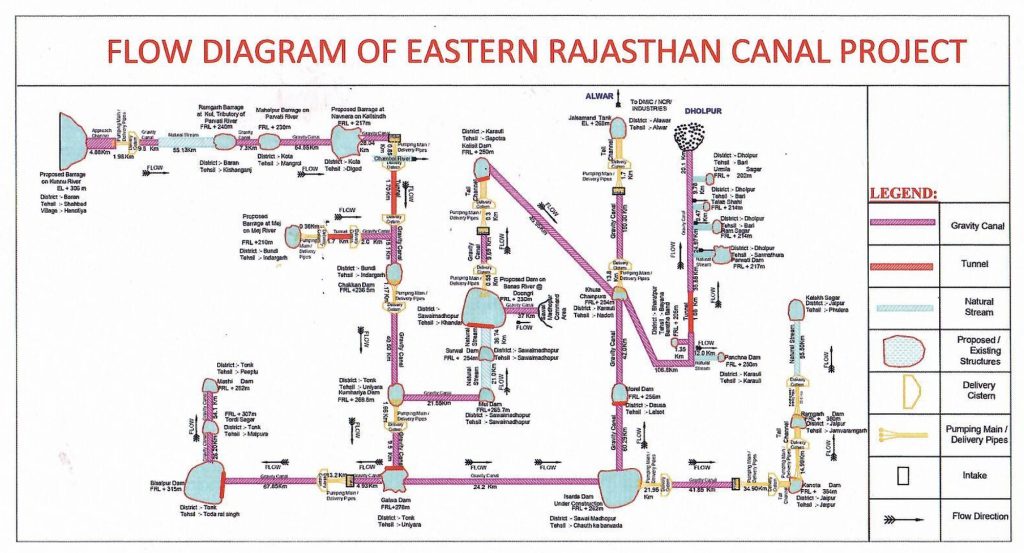Context:
Recently, a memorandum of understanding (MoU) was signed between the Union government, Madhya Pradesh, and Rajasthan governments for the ambitious Eastern Rajasthan Canal Project (ERCP).
About Eastern Rajasthan Canal Project (ERCP):
- It was designed for intra-basin water transfer within the Chambal basin.
- It aims to utilize surplus monsoon water from the Kalisindh, Parvati, Mej, and Chakan sub-basins, diverting to water-deficient sub-basins like Banas, Gambhiri, Banganga, and Parbati.
- According to Ministry of Jal Shakti, the link project aims to provide drinking and industrial water to 13 districts (Alwar, Bharatpur, Dholpur, Karauli, Sawai-Madhopur, Dausa, Jaipur, Ajmer, Tonk, Bundi, Kota, Baran, and Jhalawar) in eastern Rajasthan and the Malwa and Chambal regions of Madhya Pradesh.
- Additionally, the project is expected to facilitate irrigation in an area of around 2.8 lakh hectares in each state.
- It implements the Modified Parbati-Kalisindh-Chambal-ERCP (Modified PKC-ERCP) Link Project.
- It is designed under the center’s National Linking of River Project (NLRP).

About the Parbati-Kalisindh-Chambal (PKC) River Link Project:
- The project was devised in 1980 by the former Union Ministry of Irrigation (now Department of Water Resources) and the Central Water Commission.
- The preliminary feasibility report for the Kalisindh-Chambal link canal project was prepared and distributed to the concerned states in September 1991.
- The report suggests diverting water from the Newaj River (a tributary of Kalisindh) and Kalisindh itself to the Chambal River, proposing potential diversion points at either the Rana Pratap Sagar dam/the Gandhi Sagar dam.

National River Linking Project (NRLP) (under Ministry of Jal Shakti)
- It is an ambitious initiative aiming to interlink 14 Himalayan and 16 peninsular rivers through an extensive network of 30 canals that will result in the creation of a South Asian Water Grid.
Historical Context:
- The Concept of river interlinking in India dates back to 1858, originating from the vision of British irrigation engineer Sir Arthur Thomas Cotton.
Components of NRLP:
Himalayan Component:
- Aims to construct storage reservoirs on the Ganga and Brahmaputra rivers and their tributaries in India and Nepal.
- Proposes the connection of the Ganga and Brahmaputra basins to the Mahanadi basin and links the Eastern tributaries of the Ganga with the Sabarmati and Chamba river systems.
Peninsular Component:
- Proposes linking the Mahanadi and Godavari to feed the Krishna, Pennar, Cauvery, and Vaigai rivers, among other connections.
Benefits of River Interlinking:
- Hydrological Balance: Addresses India’s hydrological imbalance by transferring water from flood-prone regions to drought-prone areas, mitigating the impact of erratic rainfall patterns.
- Irrigation Benefits: Potential to irrigate water-scarce regions, fostering employment, boosting crop outputs, and advancing India’s progress towards food security.
- Power Generation: Potential to generate hydroelectric power, reducing reliance on coal-based plants and contributing to India’s climate goals under the Glasgow Climate Pact and the Paris Agreement.
- Water Supply: Can Provide clean drinking water, addressing issues of drinking water scarcity in India.
- Industrial Water Usage: Offers water for industrial use, supporting economic activities and industrial growth.
- Environmental Conservation: Supports fisheries and wildlife survival, particularly during water-scarce periods, and reduces forest fires associated with climatic conditions.
Challenges of River Interlinking:
- Climate Change Impact: Melting glaciers due to climate change may reduce surplus water availability in rivers, questioning the long-term sustainability of interlinking projects.
- Human Cost: Loss of livelihood and displacement, particularly affecting poor and tribal communities, necessitates careful consideration of rehabilitation efforts and addressing social concerns.
- Financial Burden: High capital requirements present a significant financial challenge and may not yield a favorable cost-benefit ratio.
- Ecological and Biodiversity Impact: Mixing waters from diverse rivers may disrupt local ecosystems and biodiversity.
- Political Hurdles: Implementation relies on inter-state cooperation; earlier rejection of ECRP by Madhya Pradesh highlights the political challenges associated with the River Linking Project.
Way Forward:
- Groundwater Management: Emphasize improving and managing the groundwater system, including identifying and protecting recharge mechanisms, enhancing recharge where possible, and regulating groundwater use at the aquifer level.
- Promote the Concept of virtual water: Advocate for virtual water, encouraging practices where countries import certain water-intensive goods instead of producing them domestically and saving local water for other purposes.
- National Waterways Project (NWP): Consider alternatives like the National Waterways Project (NWP) as opposed to the River Linking Project. The NWP acts as a water grid, requiring less land, offering year-round navigation, and involving zero pumping.

